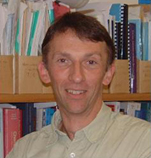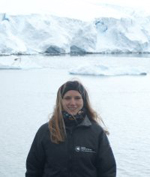|
Spring School on Fluid Mechanics and Geophysics of Environmental Hazards
(19 Apr - 2 May 2009)
~ Abstracts ~
Elements of Vortex Dynamics and Turbulence
Keith Moffatt, University of Cambridge, UK

The emphasis in this short introductory course will be on those fluid dynamical phenomena that are best understood in terms of convection and diffusion of vorticity, the curl of the velocity field. Vorticity is generated at fluid boundaries, and diffuses into the fluid where it is subject to convection, stretching and associated intensification. Far from boundaries, viscous effects may be negligible, and then vortex lines are transported with the fluid. The vortex ring, which propagates under its own self-induced velocity, is a widely observed phenomenon, and a fundamental ingredient of fluid flow. Stretching and intensification is best illustrated by the 'Burgers vortex' (the simplest model for a hurricane) in which these process are in equilibrium with viscous diffusion. In turbulent flow, the vorticity is random, but these fundamental processes still control many features of the flow. Fully three-dimensional turbulence is characterised by a cascade of energy through a broad spectrum from large scales to very small scales at which kinetic energy is dissipated by viscosity, a scenario that leads to the famous (-5/3) Kolmogorov spectrum. These topics will be reviewed and discussed with a view to geophysical application.
Project
Point vortex dynamics
Consider a system of N point vortices, each of which moves with velocity induced by all the others. Devise a numerical scheme to follow the evolution of the system. Test the code for the case N=2, for which the analytical solution is known. Then run the code for N=3 and for N=4 and for various initial conditions. Investigate whether your solutions are regular (i.e. periodic or quasi-periodic) or chaotic, and summarise your conclusions.
« Back... Tsunamis
Pavel Tkalich, National University of Singapore

Nonlinear waves are observed in all branches of science and engineering, and are present in different aspects of our daily life. The great Sumatra-Andaman (2004) tsunami in the Indian Ocean provides a pure example of a series of events dominated by nonlinear wave dynamics. This course will review tsunami behaviour at all stages, starting from a source in the open ocean, through trans-oceanic propagation, and up to breaking on shore. Major observed features of tsunami can be analysed using mathematical wave models of various complexities, such as soliton theory and Boussinesq approximation. In the past, several numerical models have been specifically developed for tsunami research and operational forecast worldwide, whereas application of general hydrodynamic solvers is becoming common due to the availability of ever-increasing computational power and resources.
Operational forecasters require instant solutions, which can as yet be achieved only using data-driven models, such as those based on Artificial Neural Networks or Empirical Orthogonal Functions.
The course will examine lessons from the 2004 Sumatra-Andaman tsunami and review the operational procedures for tsunami warning and forecast at major tsunami warning centres.
Project
Numerical modelling of nonlinear waves in shallow water
1. For beginners
Read and understand paper by Zabusky and Kruskal (1965). Write a code to solve Korteweg - de Vries (KdV) equation using numerical approximation by the authors as well as some alternative approximation of your choice. Run several cases of two-soliton interaction using both methods. Explain observed similarities and discrepancies (if any).
2. For advanced modellers
You are invited to investigate the COMCOT (2007) (Shallow Water
Equations) model. COMCOT (COrnell Multigrid COupled Tsunami model) is a tsunami modeling package, capable of simulating the entire lifespan of a tsunami, from its generation, propagation and runup/rundown in coastal regions. Use the information from the website to learn more about the model. Run attached examples, then try some real case scenarios such as Sumatra-Andaman (2004) tsunami in the Indian Ocean.
References
1. Zabusky and Kruskal (1965 Interaction of "Solitons" in a Collisionless Plasma and the Recurrence of Initial States. Phys. Rev. Lett. 15, 240 - 243
2. COMCOT User Manual Version 1.6 (2007)
http://ceeserver.cee.cornell.edu/pll-group/doc/comcot_user_manual_v1_6.pdf
http://ceeserver.cee.cornell.edu/pll-group/comcot_code/comcot_v1_6.zip
« Back... Tropical Cyclones
Kerry Emanuel, Massachusetts Institute of Technology, USA

Tropical cyclones are well known for the terrible death and destruction they bring, but their basic physics are not as well known and frequently mischaracterized. (For example, it is commonly held that these storms are driven by latent heat release, but this is not true as, for example, it is perfectly possible to have dry hurricanes.) Although they are regarded by most atmospheric scientists as "rare", there are in fact about 90 storms per year globally, and these may play an important role in the physics and biogeochemistry of the oceans.
This set of introductory lectures will begin with an overview of the observed characteristics and climatology of tropical cyclones, including their physical structure, behavior, and variations with climate phenomena such as El Niño/Southern Oscillation and global warming. The basic mechanics and energy cycle of tropical cyclones will then be discussed along with their local effect on the oceans and associated feedback to the storms themselves. Factors affecting the movement and intensity of tropical cyclones will also be described, and the state of the art of forecasting will be reviewed. In the last lecture, I will discuss some of the remaining challenges in understanding these storms, including their response to climate change and their role in regulating global climate.
Project
Tropical cyclone dynamics
This project involves working with a very simple numerical model of a tropical cyclone to explore the sensitivity of these storms to environmental and internal parameters. (The model is simple enough that it will run quickly on an ordinary laptop, but it is good enough that a version of it is used by forecasters to assist with forecasting the intensity of real hurricanes.) We will explore such issues as what environmental conditions affect the intensity, rate of development, threshold intensity of the starter vortex, and development (or not) of concentric eyewall cycles. Finally, we will explore possible ways of improving the model including the relaxation of the assumption of gradient wind balance in the boundary layer.
References
Emanuel, K., 2003: Tropical Cyclones. Ann Rev. Earth Planet. Sci., 31, 75-104
Emanuel, K.A., 1995: The behavior of a simple hurricane model using a convective scheme based on subcloud-layer entropy equilibrium. J. Atmos. Sci., 52, 3959-3968
Note: A paper by George Bryan, currently under review (and likely to be accepted) will be provided later.
« Back... Transport of Pollutants in the Atmosphere
Peter Haynes, University of Cambridge, UK

It is now realised that air quality is determined not only by local emissions and local meteorology, but also by long-range atmospheric transport of chemical species from emission regions that may be thousands or even tens of thousands of kilometres from the region of interest. Furthermore it is now possible to start to predict how global-scale climate change may affect the air quality locally.
Predicting and understanding these effects requires consideration of many different processes, including emissions, boundary layer physics, chemical reactions and interactions with clouds and particles. These lectures will in particular focus on the role of atmospheric transport and mixing, emphasising the fundamental ideas and describing relevant mathematical models. In many parts of the atmosphere large-scale quasi-horizontal flow appears to play the dominant role in transport and in the stirring process that leads ultimately to true (molecular) mixing at very small scales. This means that calculations based on large-scale meteorological datasets can give valuable quantitative information on transport. In the tropics, of course, convection plays an important additional role, and its effects need to be taken into account alongside the large-scale transport.
Project
Long-range transport and air quality
You can read about some of the important non-local aspects of air quality
in Akimoto (2003) "Global air quality and pollution" ( Science, 5 December
2003, Vol. 302. no. 5651, pp. 1716 - 1719. DOI: 10.1126/science.1092666).
Trajectory models using large-scale meteorological datasets as input are
now routinely used to quantify long-range transport. A nice example of the
application of such models is in the paper by Damoah et al (2004) "Around
the world in 17 days: hemispheric-scale transport of forest fire smoke
from Russia in May 2003" (Atmos. Chem. Phys., 4, 1311-1321, 2004.
<www.atmos-chem-phys.org/acp/4/1311/>. This paper also makes good use of
new large-scale satellite observations.)
You can view results from a trajectory model in an interactive way at the
web site <http://tarantula.nilu.no/trajectories/index.cfm>. This web site
allows you to specify location, date and time. Note that the trajectories
are backwards trajectories from the specified location (i.e. the
trajectories that arrive at the location).
The closest allowed locations to Singapore are: Tanah Rata, Bukit Kototabang
and Serpong. What you can you say about the origin of air that arrives in
these regions? Can you detect a seasonal variation? or an interannual
variation, e.g. associated with El Nino/La Nina? (A convenient El Nino/Southern
Oscillation index is given at <http://www.cdc.noaa.gov/people/klaus.wolter/MEI/>
« Back... Hydro-Meteorological and Environmental Disasters
A. W. Jayawardena, International Centre for Water Hazard and Risk Management, Japan

In these introductory lectures, an overview will be presented of the physical and biological factors that cause disasters and of their relationships in quantitative terms to the outcomes of these disasters. The course will begin with an introduction to the atmosphere, which is the starting point of all hydro-meteorological disasters, including the different processes and links that lead to precipitation. A quantitative description of the various force systems in the atmosphere, and the formulation of the governing equations including simplifications under various assumptions will then be presented. An overview of how the governing equations lead to the formulation of General Circulation Models as well as Limited Area Models will also be given. Finally, the relationship between precipitation and runoff, or floods, including their forecasting techniques will be presented.
Secondly, the lectures will cover the types and causes of water-related environmental disasters. This will be followed by a quantitative description of mixing processes by Fickian diffusion and by convective dispersion. The governing equations and simplifications for conservative and non-conservative types of pollutants, point and non-point sources of pollution, reaction kinetics for non-conservative pollutants, and modeling approaches, will then be presented. As the health of a water body is measured by the dissolved oxygen concentration, an introduction to the oxygen sag curve in rivers will also be given. Finally, an overview of environmental accidents such as oil and toxic waste spills and an introduction to ecological disasters such as eutrophication and growth of harmful algal blooms such as "red tides", will be presented.
Project
River pollution
Consider a river in your country for which the following information can be found:
Width of river
Depth of flow
Bed slope
Manning's roughness coefficient 'n'
(You need this information to estimate the velocity, flow rate and the longitudinal dispersion coefficient)
(1)Construct the concentration-distance (at least for 3 time levels) and concentration-time profiles (at least for 3 downstream points) of the fate and transport of an assumed accidental instantaneous spill of a conservative toxic material of unit mass into the river. Choose the distance and time bases of the concentration profiles to attain near zero values asymptotically.
(2)Repeat (1) above assuming that the toxic material is non-conservative and has a decay constant of 0.1/day
(3)Use the concentration profiles obtained in (1) above to re-estimate the longitudinal dispersion coefficient by the change of moment method and the routing method.
(4)Simulate the scenario that may have followed after one of the worst environmental disasters happened in Northeastern China when about 100 Tons of toxic chemicals consisting of Benzene, Nitrobenzene and Aniline spilled into Songhua River (a tributary of Amur River) on November 13, 2005. Quantitative information about this incident is not easy to find, but the internet may give some clues. Make reasonable assumptions where necessary. As a first approximation you may use the properties of linear systems and extrapolate the results from (1) above.
(5)Instead of an instantaneous spill, if there has been a continuous discharge (such as for example BOD from sewage works) maintaining the pollutant concentration at the discharge point at 30 mg/l, what would be the corresponding concentration profiles?
References:
Thomann, R. V and Mueller, J. A. (1987) : Principles of surface water quality modeling and control, Harper & Row. (Chapter 2)
Fischer, H. B., et. al (1979): Mixing in inland and coastal waters, Academic Press.
« Back... Geophysical and Environmental Fluid Mechanics
Tieh Yong Koh, Nanyang Technological University

These introductory lectures will discuss the basic mechanics of stratified, rotating fluids as the background to geophysical and environmental flows. Topics to be covered include: stable stratification and internal waves; gravity currents; plumes and convective flows; similarity theory of the atmospheric boundary layer; geostrophic motion and inertial waves; geostrophic adjustment.
Joint work with Paul Linden, University of California San Diego, USA.
Project
Buoyant plumes
Hot gases rising from a smoke stack form a buoyant plume. A plume is also a fundamental feature of convection and responsible for the transport of pollutants in convective flows. This project will involve setting up a plume in a laboratory tank and observing the behaviour of the plume and its impact on the surroundings.
For background reading see
Linden, P.F. 2000 Convection in the environment. Perspectives in Fluid Mechanics, Eds. Batchelor, G.K, Moffatt, H.K. & Worster, M.G, Cambridge University Press, pp. 287-343
« Back... Aspects of Climate Change
Emily Shuckburgh, British Antarctic Survey, UK

Fluid dynamics is at the heart of our climate system, governing the motion of the atmosphere, oceans and ice sheets. Indeed, as will be described in these lectures, the equations of motion for a fluid on a rotating sphere form the core of the numerical climate models used to predict future change. The spherical shape of the Earth leads to different approximations being appropriate within and outside the tropical regions. Aspects of weather phenomena such as mid-latitude winter storms and the tropical monsoons can be understood in this way. The Pacific and Atlantic Oceans are bounded in longitude by the continents, whereas the Southern Ocean is not. This leads to the dominance of different physical processes and hence different circulation patterns, as will be described. Some processes, such as those associated with the El Niño Southern Oscillation, can only be understood in terms of the coupled dynamics of the atmosphere and ocean. In both the atmosphere and the oceans, global-scale overturning circulations transport heat as well as chemical species around the Earth. The physical mechanisms responsible for these aspects of the climate system will be reviewed, and their potential for change with increased atmospheric greenhouse gas concentrations will be discussed.
Project
Climate modelling
You are invited to investigate the climate model described in
< http://climateprediction.net>
There won't be enough time to do a complete run of this model - that takes 3-4 weeks usually - but you can see the model in action and use the information from the website to learn more about how climate models are constructed, and to analyse some of the predictions that have been made with this model.
« Back... Extreme Rain and Wind Storms in Mid-Latitudes
Gerd Tetzlaff, Universität Leipzig, Germany

Extreme precipitation (rain) and subsequent flooding are a major environmental hazard. Methods have been developed, mainly on a statistical basis, to estimate maximum probable or even maximum possible precipitation. Higher resolution weather forecast models, with complex representation of the physical processes involved, can be used for calculation of maximum precipitation. This requires input data with known probabilities, but also allows for estimation of the sensitivities of relevant parameters. Orographic (mountain) structures are a major influence in the formation of very high precipitation. The model applied here is used to study the sensitivity of orographic influence. The long-term climatic development of heavy precipitation and floods in Europe during recent centuries will be used to illustrate these numerical studies.
In the mid-latitudes windstorms are a major hazard. A recent event in Germany alone caused material damage exceeding 10 billion euros. A weather forecast mesoscale model is applied to investigate the sensitivity of mid-latitude baroclinic waves to the large-scale background circulation parameters. The main parameters are contained in the spatial distributions of temperature and humidity. The calculations show that, with few exceptions, strong wind events are usually rather close to their maximum. However, there is a large variation among about 100 storm events that have been investigated. The role of water vapour was in most cases, again with few exceptions, found to be irrelevant.
Project
Vapour-condensation and rainfall
Background to maximum rain and maximum wind in the mid-latitudes
Extreme weather events are the major disaster bringers worldwide. More than 90% of all people affected (injured, homeless,etc.) by disasters are hit by hydro-meteorologically induced ones. The long-term observed climatic conditions give the basic information on what size of weather event to expect with what frequency. Usually most human activities are designed to withstand adverse weather to a certain degree. This degree depends on many conditions, and often protective systems are meant to withstand weather events occurring with a frequency of less than one event per 100 years. All events exceeding this events size potentially cause disasters and may indeed occur. Mostly, better protection usually is rated as non-affordable. The threshold values designating the so called 100 year event size can be calculated from observations with some robustness. However, for many questions it necessary to access information on the physically maximum event size. Estimates require complex models and the availability of the appropriate input data.
The maximum rain in mid-latitude conditions is observed at mountain ranges, sustaining upward motion in the atmosphere for a prolonged period of time. In the free atmosphere the formation of vertical motion is coupled to moving cyclones, usually not allowing quasi-stationary conditions over one day or longer. It is only few parameters like temperature, pressure, dew point temperature, density and wind velocity that allow the description of the formation of rain and wind. The basic set of equations to be applied comprises the conservation of energy (adiabatic lapse rates) and momentum (hydrostatic balance) and the equation of state. The formation of strong wind is rather complex, including the production of baroclinicity, of vorticity, together with formation of locally strong winds by convective processes.
Suggested reading : James R. Holton, 'Introduction to Dynamic Meteorology',Academic Press, 3rd Edition 1992.
Dennis L. Hartmann, 'Gobal Physical Climatology', Academic Press, 1994.
1. Project 1 (maximum mid-latitude rain)
Rain is produced, when water vapor is cooled to dew point temperature. Usually an air parcel cools when moved upwards, following the adiabatic lapse rates. The amount of condensate per time interval depends on several parameters at the starting level for the upward moving air parcel: dew point temperature, the air temperature, pressure and the upward velocity.
A 2-dimensional mountain range has a crest height of 2 kilometers with a linear slope of 1 kilometer vertical for 25 horizontal kilometers. Initially the air column has a temperature of 21°C and a dew point temperature of also 21°C following a moist adiabatic lapse rate to the top of the column in 12 kilometers height. Then this air column is moved perpendicularly across the crest being lifted moving along the mountain slope with the geometric lift assumed to be height independent. The air flows at 20 m/s, the velocity assumed to be height independent as well. Calculate the amount of condensed water produced in the column, when moving the column across the mountain slope in 24 hours for each 500 meters of height. The rain is assumed to fall vertically to the surface exactly at the position where it is produced within the column. Try to estimate the sensitivity of the results with respect to the used conditions (air temperature, dew point temperature, wind velocity) and the assumptions made (vertical motion height independent, horizontal velocity height independent, rain falls vertically from the whole column). Compare the rain amounts calculated to observed maximum rain rates.
2. Project 2 (maximum mid-latitude wind)
A major ingredient for formation and intensity of mid-latitude cyclones is the temperature gradient between equator and pole. Averaged over the whole troposphere this temperature difference often amounts to 30K. In the mid-latitudes the polar front signifies the zonally oriented border zone between the tropic and the polar air masses, concentrating a significant part of the overall temperature difference equator-pole. Assuming this concentration to be 15 K per 100 kilometers in a latitude of 50°N, what is the geostrophic wind velocity at 300 hPa, assumed to be the top of the troposphere. The surface pressure is homogenous and 1000 hPa, the surface temperature is 0°C on the cold side, 15°C on the warm side. What is the coupling of the frontal zone wind speed to maximum surface wind speed?
« Back... Dynamics of the Indian and Pacific Oceans
Swadhin Behera, Japan Agency for Marine-Earth Science and Technology (JAMSTEC), Japan

Tropical oceans play a major role in natural variability of the world climate Anomalous coupled ocean-atmosphere phenomena generated in the tropical oceans produce changes in global atmospheric and oceanic circulation that influence regional climate conditions even in remote regions. On the interannual time-scale, the El Niño /Southern Oscillation (ENSO) of the tropical Pacific Ocean is known as a typical example of such phenomena and has received worldwide attention because
of its enormous societal impact.
However, various ocean/atmosphere datasets in recent decades suggest the existence of a new climate mode in the tropical Pacific, which is different from conventional El Niño. The unique central Pacific warming of this new mode is associated with a horseshoe sea surface temperature (SST) pattern, and is flanked by a colder anomaly on both sides along the equator. Such a zonal SST distribution results in anomalous two-cell Walker circulations over the tropical Pacific. Both Intertropical Convergence Zone (ITCZ) and South Pacific Convergence Zone (SPCZ) expand poleward, forming a wet region in the central tropical Pacific. Since the mode cannot be described as one phase of El Niño evolution, the phenomenon may be called El Niño Modoki (or Pseudo-El Niño). The El Niño Modoki involves ocean-atmosphere coupled processes, indicating the existence of a unique atmospheric component during the evolution, analogous to the Southern Oscillation in the case of El Niño. The Modoki's impact on world climate is very different from that of ENSO. Possible geographical regions for droughts and floods influenced by Modoki and ENSO are compared. Interestingly, the Modoki's influences over regions such as the Far East including Japan and the western coast of USA are almost opposite to those of the conventional ENSO. The difference maps between the two periods 1979-2004 and 1958-1978 for various oceanic/atmospheric variables suggest that the recent weakening of equatorial easterlies related to a weakened zonal sea surface temperature gradient led to more flattening of the thermocline in the equatorial Pacific. This appears to be a cause of more frequent and persistent occurrence of the Modoki event during recent warming decades.
In contrast to the Pacific, the interannual variability originating in the tropical Indian Ocean has received less attention. However, it has turned out that the anomalous event in 1994 is due to an ocean-atmosphere coupled phenomenon. This coupled mode is now widely called the Indian Ocean Dipole (IOD). During the IOD event, an east-west zonal dipole pattern of sea surface temperature (SST) evolves in the tropical Indian Ocean. The SST pattern is associated with zonal surface wind anomalies. Changes in the surface winds are associated with surface pressure anomalies just as in the ENSO of the Pacific. The IOD has its unique teleconnection pattern that implies regional climate variability and thus societal impacts in various parts of the globe. Since IOD and ENSO indices are not completely orthogonal, the IOD influences must be carefully appreciated for societal application purposes. Recent statistical and dynamical studies have clearly revealed that the enhancement of the East African short rains is due to IOD rather than El Niño, in contrast to the conventional view.
Appreciating the differences among various climate modes and their impacts as discussed above will enhance our understanding of coupled ocean-atmosphere dynamics and thus contribute to improved prediction of seasonal climate and abnormal weather events.
Joint work with Toshio Yamagata, The University of Tokyo, Japan.
Project
The Indian ocean dipole and ENSO
Understanding the variations of the Indian Ocean Dipole (IOD) besides El Niño/Southern Oscillation (ENSO) is important for climate studies of the Indo-Pacific sector. The IOD rooted in the Indian Ocean influences the amplitude and the periodicity of ENSO. Therefore, a careful analysis of observed and model simulated data is necessary to realize ENSO behavior. In this project, students will explore frequency, amplitude, seasonal evolution and propagation characteristics of ENSO. To elucidate the IOD influence, we will compare two contrasting El Niño events of 1997-98 and 2006-07. In particular, we will verify how the late evolution of IOD could influence the amplitude and the life-span of El Niño from the example of 2006-07 event.
References:
http://www.ncdc.noaa.gov/oa/climate/research/2006/enso-monitoring.html
Behera, S. K., and T. Yamagata, 2003, Influence of the Indian Ocean Dipole on the Southern Oscillation. J. of the Met. Soc. of Japan, 81, 169-177.
Annamalai, H., S.-P. Xie, J.P. McCreary, and R. Murtugudde, 2005: Impact of Indian Ocean sea surface temperature on developing El Niño. J. Climate, 18, 302-319.
Behera, S. K., J.J. Luo, S. Masson, S. A. Rao, H. Sakuma and T. Yamagata,
2006: A CGCM study on the interaction between IOD and ENSO, J. Climate, 19, 1608-1705.
« Back... Mathematical Modeling and Experiments Studying Nonlinear Instabilities, Rogue Waves and Extreme Phenomena
Frédéric Dias, Ecole Normale Supérieure de Cachan, France

Extreme value phenomena have dramatic impact in many fields within both the physical and social sciences, and are thus the subject of intense international research. The potential of a given system to generate extreme events is a reflection of the complexity of the underlying dynamics, and a central challenge in understanding extreme value phenomena is to develop rigorous models linking these dynamics and the associated statistical behaviour. The scientific study of extreme value phenomena, however, has been significantly hampered in two ways:
(i) the intrinsic scarcity of the events under study and (ii) the fact that such events often appear in environments where measurements are difficult. These unavoidable problems have led to an absence of extensive data sets generated under controlled conditions, resulting in associated difficulties in studying their generation mechanisms and statistical properties in a quantitative manner.
In this context, however, recent research from the domain of optical physics published in Nature in late 2007 suggests a solution [D. Solli et al. Nature 450, 1054-1057, Dec 2007]. In particular, this research has shown that a convenient laboratory-based optical fibre system can generate extreme value events with similar properties to the large amplitude hydrodynamic rogue waves observed on the surface of the ocean.
In fact, although analogies between linear and nonlinear wave propagation in hydrodynamics and optics have been known since the 1960's, the significance of the 2007 Nature article is that it reports a novel experimental technique for directly quantifying the extreme statistical fluctuations that arise from complex multisoliton dynamics during the nonlinear process of white light supercontinuum generation.
Of particular importance is the fact that the high repetition rate of optical sources allows the convenient generation of large data sets even for heavy-tailed probability distributions expected of extreme value phenomena where the rare events under study occur with extremely low probabilities.
These 2007 results represent a key advance that has opened up the possibility for an optical system to be used to directly and conveniently study extreme-value processes, potentially representing an advance comparable to the first use of optical systems to study nonlinear chaos in the 1970's. The lecture will discuss how these recent results can advance understanding in the theoretical analysis, numerical modelling and predictive description of extreme value phenomena in optical-hydrodynamic like systems.
« Back... Rapid Assessment of Earthquake Source Parameters using Mathematical Models
Soon Hoe Chew, National University of Singapore

The 2004 Sumatra-Andaman earthquake generated a huge tsunami that killed about 300,000 people. About 90% of all the tsunamis are caused by earthquakes. Currently, the tsunami warnings are mainly based on the earthquake magnitude and epicenter location. However, such warnings continue to be a hit-or-miss proposition at the present time with more than 50% of the warnings issued by Pacific Tsunami Warning Center (PTWC) end up as false. This is because the mechanism of tsunami generation is very complex: e.g. large earthquake (Mw>7) occurring in deep sea can cause tsunami, but yet not all such earthquakes cause tsunamis.
Hence, for an "accurate" prediction of the tsunami generation, its source parameters should be evaluated near real-time. Some key components of this source parameters are: seismic moment, focal mechanism and focal depth. A mathematical model was developed to enable the computation of these source parameters near real-time. Then these parameters can be used as input to the numerical model for the tsunami wave propagation to forecast the tsunami arrival times and wave heights. This talk will focus on the application of the mathematics in determining these source parameters in a very short time after the earthquake occurrence. This is one of the key requirements for the modern and effective early tsunami warming system.
« Back... Natural and Human Induced Environmental Hazards & Disasters
Harsh Gupta, National Geophysical Research Institute (NGRI), India

With the passage of time, the impact of natural hazards is on an increase globally. In the recent past, we had the most devastating tsunami generated by the second largest ever-recorded Mw 9.3 Sumatra earthquake of 26th December 2004. It is estimated that about 280,000 human lives were lost. The Muzzafarabad earthquake of October 8, 2005 claimed an estimated 88,000 lives. The 2005 Hurricane Katrina in the US killed 1840 human beings, destroyed 170,000 homes and inflicted a financial loss of about 82 billion US $. During 2008 the Sichuan earthquake in China and Nargis cyclone in Myanmar topped the disaster list. Earthquakes triggered, as a consequence of filling artificial water reservoirs is a classical example of human induced hazard. At several places, the triggered earthquakes exceeded M 6 and were locally very damaging. The frequency of natural disasters is rising rapidly. From about 100 per decade in the earlier part of the 20th century, it rose to 2800 per decade towards the end of the 20th century. Considering the impact of natural disasters on humanity, ICSU is implementing a program 'Integrated Research on Disaster Risk (IRDR)' of research aimed at strengthening international science to provide a firmer basis for policies to prevent natural hazards from becoming disasters. The most significant research gaps are in interdisciplinary cohesion: intersection of the natural, social and political sciences; and the issue of how knowledge about hazards is, or can be put to use. In spite of the growth in knowledge, the losses from natural hazards are on an increase. The issue is most relevant for the Asian region, which accounts for about 80% of total human lives lost globally due to natural disasters. ICSU's Regional Office for Asia and Pacific (ROAP) is addressing three natural hazards, earthquakes, landslides and floods and the special vulnerability of islands in the region to the natural hazards. A couple of examples are cited to demonstrate how the application of scientific and technological developments, interwoven with social fabric, improved the situation.
« Back... Venice: finally out of peril !
Paola Malanotte-Rizzoli, Massachusetts Institute of Technology, USA

The Venice problem of exceptional floods cam to the world attention on November 4, 1966, when the city was submerged for 2 days under 2 m. of water due to the Adriatic sea most extreme storm surge. The scientific issues connected with the flood problem , man-induced subsidence and floods, are reviewed . After almost 40 years of bitter political contentions, in May 2004 the works started for the construction of mobile gates to the 3 inlets of the Venice lagoon. These gates will be raised when the models predicting the sea level in Venice will give the warning of forthcoming anomalous sea levels 1, 10 m above the normal. Closed, the gates will separate the Venice lagoon from the Adriatic sea preventing the floods. The gates project will be also illustrated and most recent pictures of the state of the works will also be shown. The gates constitute an enormous engineering project, much bigger than those that led to the construction of the mobile gates along the Holland coastline or in the Thames in London. They will be completed in 2014.
« Back... Fluid Mechanics And Volcanic Processes
Chris Newhall, Nanyang Technological University

Multiphase fluid mechanics control all stages of volcanic activity, before, during, and after eruptions. Magma is molten rock with variable quantities of dissolved volatiles, bubbles, and crystals. As magma rises from depths of 10's-100's of km into the volcanic environment (top 10 km or so), confining pressure decreases, volatiles reach saturation and start to move into bubbles, and crystals grow. Temperature may drop slightly, but with relatively minor effect compared to pressure-related changes. Mixing of fresh magma from depth into existing reservoirs, and subsequent escape of gas from magma reservoirs and conduits to the surface, are key to understanding subsequent eruptive behavior. Mechanically and thermally induced changes in groundwater, and subsequent flashing, overprint eruptions and their precursors.
When gas-rich magma nears the surface, confining pressure can drop suddenly and the magma can expand rapidly, fragment, and erupt explosively. Jets of fragmented magma and hot gas rise into the atmosphere from whence they either collapse back onto the slopes of the volcano (pyroclastic density currents) or become elongate plumes that "rain" coarse fragments close to the volcano and fine ash hundreds and even thousands of km downwind. Gas-depleted (and/or relatively fluid) magma can emerge as lava flows or domes.
After eruptions and initial deposition, fragmental debris is often remobilized by rainfall and streams into dense slurries (hyperconcentrated or debris flows, known collectively as lahars) that bury nearby lowlands. Ash falling onto water forms instabilities and sinks as plumes.
Most of these processes occur over seconds to decades. In the larger picture, sediment and water from volcanoes is recycled via subduction zones in ~ 106 y.
« Back... Tsunamis
Dao My Ha, National University of Singapore
Nonlinear waves are observed in all branches of science and engineering, and are present in different aspects of our daily life. The great Sumatra-Andaman (2004) tsunami in the Indian Ocean provides a pure example of a series of events dominated by nonlinear wave dynamics. This course will review tsunami behaviour at all stages, starting from a source in the open ocean, through trans-oceanic propagation, and up to breaking on shore. Major observed features of tsunami can be analysed using mathematical wave models of various complexities, such as soliton theory and Boussinesq approximation. In the past, several numerical models have been specifically developed for tsunami research and operational forecast worldwide, whereas application of general hydrodynamic solvers is becoming common due to the availability of ever-increasing computational power and resources.
Operational forecasters require instant solutions, which can as yet be achieved only using data-driven models, such as those based on Artificial Neural Networks or Empirical Orthogonal Functions.
The course will examine lessons from the 2004 Sumatra-Andaman tsunami and review the operational procedures for tsunami warning and forecast at major tsunami warning centres.
« Back...
|
|